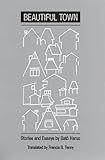Beautiful Town : Stories and Essays / Sato Haruo.
Material type: TextPublisher: Honolulu : University of Hawaii Press, [1996]Copyright date: ©1996Description: 1 online resource (280 p.)Content type:
TextPublisher: Honolulu : University of Hawaii Press, [1996]Copyright date: ©1996Description: 1 online resource (280 p.)Content type: - 9780824861582
- 895.68
- PL838.A86.A28 1996eb
- online - DeGruyter
| Item type | Current library | Call number | URL | Status | Notes | Barcode | |
|---|---|---|---|---|---|---|---|
 eBook
eBook
|
Biblioteca "Angelicum" Pont. Univ. S.Tommaso d'Aquino Nuvola online | online - DeGruyter (Browse shelf(Opens below)) | Online access | Not for loan (Accesso limitato) | Accesso per gli utenti autorizzati / Access for authorized users | (dgr)9780824861582 |
Browsing Biblioteca "Angelicum" Pont. Univ. S.Tommaso d'Aquino shelves, Shelving location: Nuvola online Close shelf browser (Hides shelf browser)

|

|

|

|

|

|

|
||
| online - DeGruyter Banished! / | online - DeGruyter Barons, Brokers, and Buyers : The Institutions and Cultures of Philippine Sugar / | online - DeGruyter Basho and the Dao : The Zhuangzi and the Transformation of Haikai / | online - DeGruyter Beautiful Town : Stories and Essays / | online - DeGruyter Begin Here : Reading Asian North American Autobiographies of Childhood / | online - DeGruyter The Beginning of Heaven and Earth : The Sacred Book of Japan's Hidden Christians / | online - DeGruyter Being Benevolence : The Social Ethics of Engaged Buddhism / |
Frontmatter -- Contents -- Translator’s Preface -- Introduction -- Stories -- Beautiful Town -- The Fingerprint -- F*O*U -- The Star -- Unbearably Forlorn -- A Window Opens -- Essays -- A Discourse on “Elegance” -- The Joy of the Artist and Other Critical Selections
restricted access online access with authorization star
http://purl.org/coar/access_right/c_16ec
Sato Haruo has been called one of the most representative writers of the Taisho era (1912-1926), a transitional period following Japan's monumental push toward modernization. Although he never identified himself as a modernist, Sato exhibited what some writers have identified as a characteristic of modernism: a complex net of contradictory impulses that embrace both the revolutionary and the conservative, revealing both an optimistic looking to the future and a pessimistic nostalgia for the past. Six stories of amazing diversity and two critical essays revealing the understated Japanese ideals of beauty make up this volume, all translated into English for the first time. Forming a sequel to the three stories published in Sato's The Sick Rose, these stories exhibit an extraordinary variety of themes and styles, ranging from poetic fairy tales to psychological portraits to who-done-it crime stories. The title story is a utopian dream of a better city, populated by ideal people, that vanishes in a mirage. Another tale portrays the loneliness of a man unsuccessful with women. A third embellishes a bare Basho haiku about the man next door. Here too are the dream ballad of a Chinese prince, the imaginary world of a mad Japanese artist in Paris, and the probing search for an opium-drugged murderer. Sato's critical essays that conclude this volume have their themes in an exploration of the sad beauty of impermanence, the nature of enlightenment, the awareness of self, the merging of the instant and the eternal, and the "self-indulgent, unrestrained beauty" of the Japanese language. This collection not only affords insights into the complexity of the work of a gifted writer, but also significantly broadens the perspective of the literary world of the Taisho period.
Mode of access: Internet via World Wide Web.
In English.
Description based on online resource; title from PDF title page (publisher's Web site, viewed 02. Mrz 2022)


